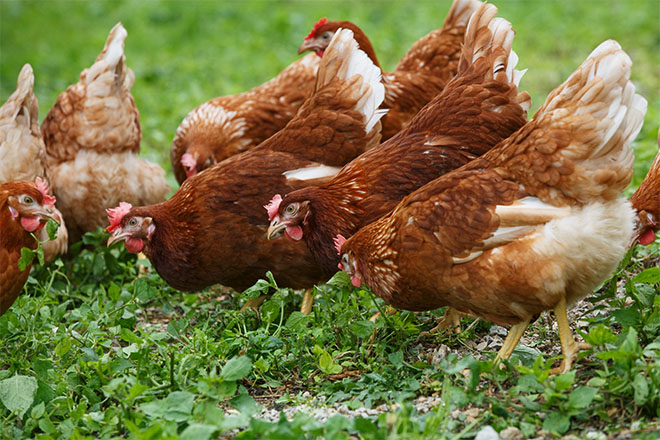Posted July 5, 2021
There are many questions for egg producers to consider at this time of year.
How many eggs should you expect from a laying hen per year? And how much of an impact does the time of year and type of feed play in egg production?
We’ve asked our in-house nutrition team for the latest on egg production to shed some light on these topics for both egg producers and hobby farmers alike.
How many eggs can you get from a laying hen?
With proper nutrition and living environment, most of the commercial strains of laying hens (such as Hyline, Lohmann, ISA Brown and Shaver) can produce around 310-320 eggs in their first laying year.
In a natural situation, hens start laying eggs when they reach maturity. Without photo stimulation, maturity is determined by body weight/condition. Once the photo stimulation process starts, the body condition will no longer control the laying age. Body weight/condition, however, will still determine the longevity of the hen and eggshell quality. This means, hens may start laying eggs due to proper light stimulation even when their bodies are not properly prepared. In this case, the laying hen’s laying longevity and eggshell quality will be compromised.
Factors influencing egg production are cumulative by duration of light, nutrition, age of hens and environmental stressors.
Daylight Influence
The duration of daylight also refers to any additional artificial light source provided. An increasing daylight initiates the start of laying. Once hens are laying, the total duration of daylight will still influence egg production. With a total duration of daylight at 16 hours per day, sufficient egg production can be maintained.
The Importance of Nutrition
Once laying hens consume around 15g of protein, the protein level will no longer affect egg production, and energy consumption will be the main contributing factor. Protein consumption, or methionine consumption to be precise, will affect the egg size alone with linoleic acid level (omega-6).
Calcium and phosphate levels will affect eggshell quality and a hen’s laying longevity. If calcium consumption is not enough, hens will withdraw calcium required from their own bone reserve and eventually stop laying once the calcium reserve is no longer available. Providing extra shell grit, especially during the evening, is a very practical way to ensure hens consume enough calcium for their next day’s production.
Water is the most important nutrient: without water consumption, hens won’t eat feed and won’t survive. Always provide clean, fresh, and clear water to make sure hens drink the proper amount.
Although providing hens with raw feeds, such as lucerne hay or raw grains, will encourage hens to eat more feed, it is suggested to limit to a maximum of 10% of total feed by weight. Hens are unable to utilise pasture effectively, so when hens consume too much leafy greens or pasture, the total nutrient consumption will be diluted by fibre. It will result in a lower egg production and poor eggshell quality. Therefore, introducing hens to pasture too quickly or too early, before hens settle their eating behaviour on proper grain feeding, is not recommended.
Age of Hens
Hens start laying their first egg at 18-20 weeks of age and the first laying years will be very productive. As the hens get older, the egg production and eggshell quality declines. Hens may start moulting, which is a process that causes hens to lose feathers and regrow feathers, after 70-80 weeks of age, especially during wintertime. The moult period may last 2 months, during which hens stop producing eggs, using this period to top up body reserves of calcium and other nutrients. After moulting, with proper calcium consumption, hens will return to laying a good number of eggs (around 85% production) with good eggshell quality.
Environmental Stressors
In addition to inconsistent light duration and poor nutrition, other stressors can also affect egg production. Other factors include:
- Predators
- Cold drafts
- Dramatic weather changes (temperature, humidity, sudden storms etc.)
- Aggressive companion birds
- Sudden loud noises
- Unexpected strangers
- Sudden changes to feeding routine
- Disease
Some stressors may cause a sudden drop of egg production, as large as 40%, known as Egg Drop Syndrome. Most of the production decline may also involve some levels of eggshell quality decrease.
If you would like to learn more about egg production, ways to encourage your hens to lay more or prepare for the cold months ahead, reach out to our Nutrition Team.
Jason Lu, Animal Nutritionist, M.App.Sc., M.Ed., has more than 25 years of experience on monogastric animal nutrition and behaviour.
References
Bestman M., Ruis M., Heijmans J. and van Middelkoop K. 2012. Poultry signals.
Hy-Line alternative systems-Australia management guide. 2016
ISA Brown Commercial management guide. 2015.
Leeson S. and Summers J. D. 2005. Commercial poultry nutrition.
Lohmann brown classic layers management guide. 2021





 Beef
Beef
 Dairy
Dairy
 Sheep
Sheep
 Horse
Horse
 Pig
Pig
 Goat
Goat
 Poultry
Poultry
 Bird
Bird
 Dog
Dog
 Special
Special
 Feed Materials
Feed Materials